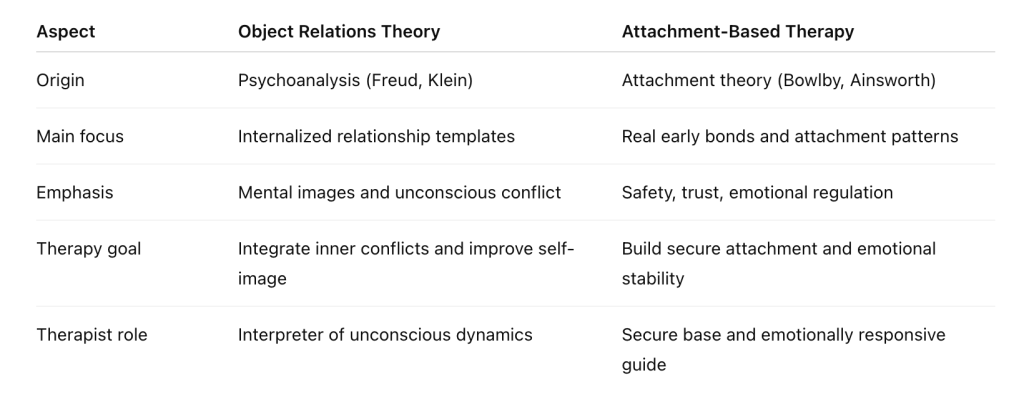Object relations theory and attachment-based psychodynamic therapy are two important approaches within the larger field of psychodynamic counseling. Both focus on how early life relationships shape our emotional lives and how we relate to others in adulthood. While they share similar foundations, they differ in focus, method, and how they view the role of early caregivers. To understand these approaches clearly, it’s also important to see how they fit within the broader psychodynamic tradition.

What are psychodynamic approaches?
Psychodynamic therapy is based on the idea that early life experiences—especially those involving family and caregivers—unconsciously influence our present thoughts, emotions, and behavior. This tradition began with Sigmund Freud’s psychoanalysis, which focused on unconscious drives, defense mechanisms, and childhood conflicts. Over time, other models emerged, including object relations theory and attachment theory, each offering a new perspective on how people develop emotionally.
Object relations theory: inner templates from early relationships
Object relations theory focuses on how children mentally and emotionally internalize their early relationships, especially with caregivers. In this context, “objects” refer not to things, but to important people in the child’s life—usually the mother or caregiver. The term “relations” points to the emotional connection the child has with these figures.
Over time, these internalized relationships become mental templates that influence how the person relates to others throughout life. For example, if a child grows up with a rejecting parent, they may carry an unconscious expectation that others will reject them too. These patterns often play out in adult relationships and may cause emotional struggles without the person fully understanding why.
Object relations theory also includes concepts like:
- Internal objects: Emotional images of caregivers stored in the mind
- Splitting: Viewing people or the self as all good or all bad
- Projection: Placing unwanted feelings onto others
- Transference: Repeating past emotional patterns in current relationships
This approach is especially useful for understanding identity development, long-term emotional patterns, and relationship struggles.
Attachment-based psychodynamic therapy: healing through connection
Attachment-based therapy, while still psychodynamic in nature, focuses more on the real emotional bonds a child forms with caregivers. Based on John Bowlby’s attachment theory, it emphasizes how the quality of those early bonds affects a person’s ability to feel safe, regulate emotions, and form healthy relationships later in life.
Children who receive consistent and nurturing care usually develop secure attachment, leading to emotional confidence and trust in others. Those who experience neglect, unpredictability, or fear may develop insecure attachment styles—such as anxious, avoidant, or disorganized. These styles continue into adulthood and influence how people connect with partners, friends, or even therapists.
In therapy, the therapist provides a secure and emotionally attuned relationship, which allows the client to form a new kind of attachment. This new experience helps repair the damage caused by early relational wounds.
Key differences between the two
While both approaches explore early relationships and their effects on adult behavior, the differences can be summarized as:
! Object relations theory focuses on how internal images of early relationships affect identity and relationship patterns.
! Attachment-based therapy focuses on how actual early caregiving experiences shaped emotional security and the ability to form close connections.
! Object relations emphasizes unconscious fantasy and internal conflict, while attachment-based therapy emphasizes emotional regulation and real-life bonds.
! In therapy, object relations often uses interpretation, while attachment-based therapy focuses more on building a healing relationship.
Conclusion
Both object relations theory and attachment-based psychodynamic therapy help people understand the emotional roots of their struggles, especially in relationships. They are part of the larger psychodynamic family, which values insight, emotional reflection, and the power of early experiences. Whether a person needs to explore unconscious patterns or repair broken trust from childhood, both approaches offer meaningful paths toward healing and personal growth.
